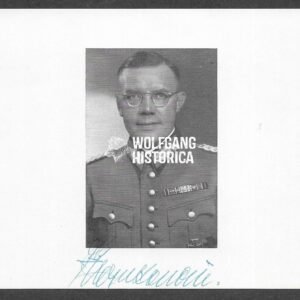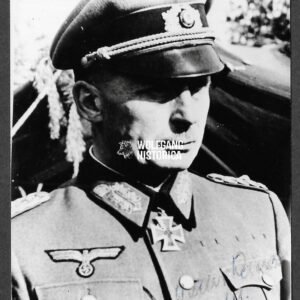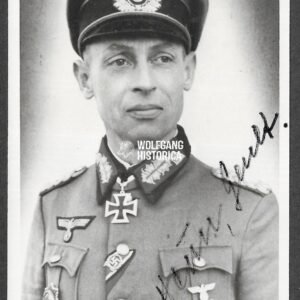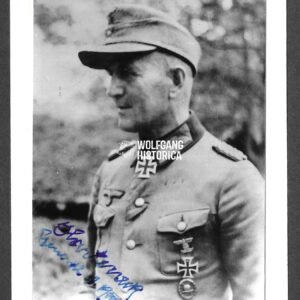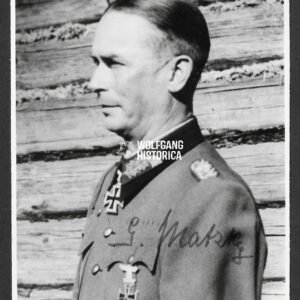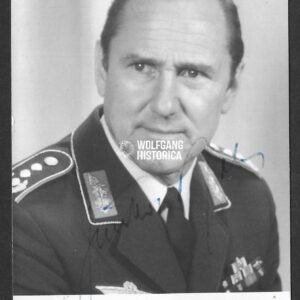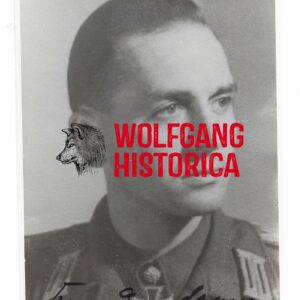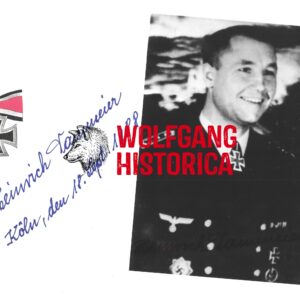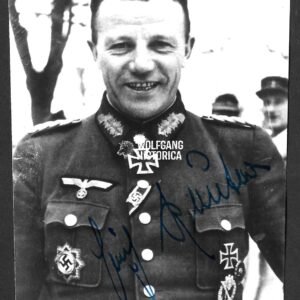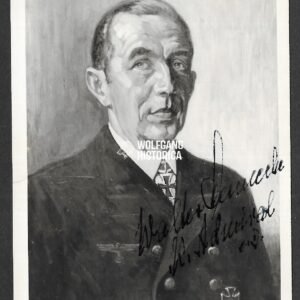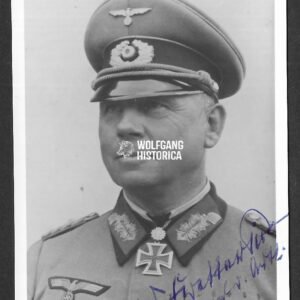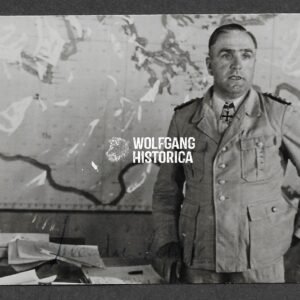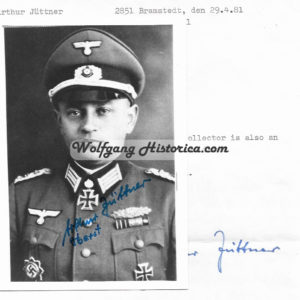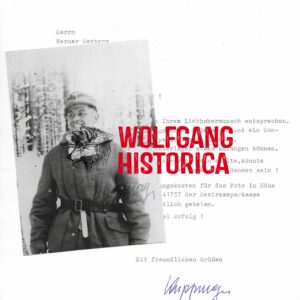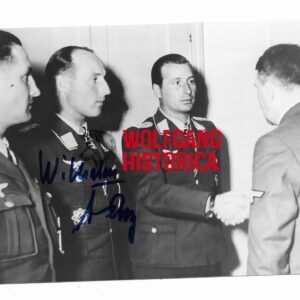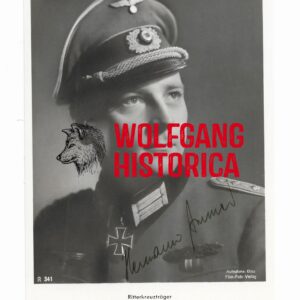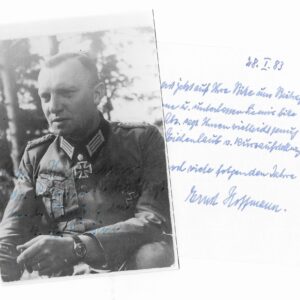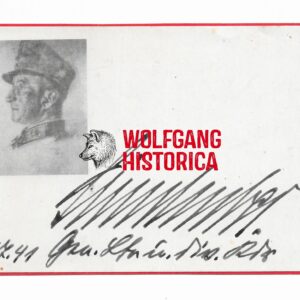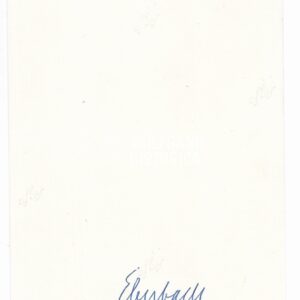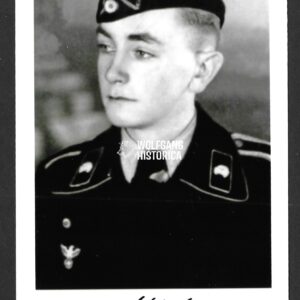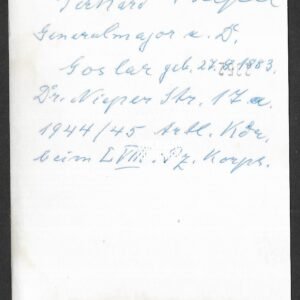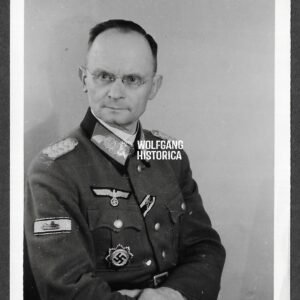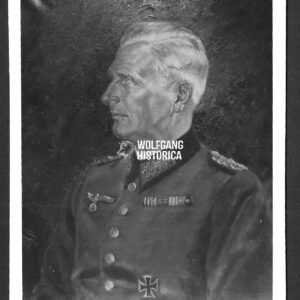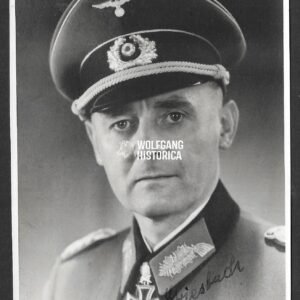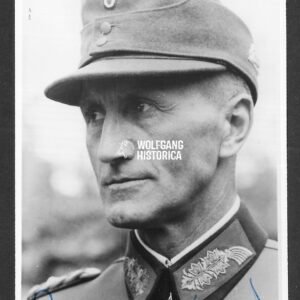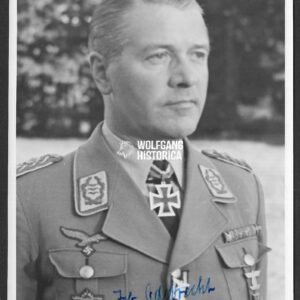Johannes Fink – Kampfgeschwader 2
€35,00Original Postwar Signature on a Postwar Photo of Johannes Fink. Generalleutnant Johannes Fink (28 March 1895, Pfullingen † 1 June 1981, Pfullingen) was a highly decorated Luftwaffe officer during World War II, ultimately rising to the rank of Generalleutnant. A veteran of both World Wars, Fink began his service in the German Army during WWI and transferred to the Luftwaffe in the interwar period. He became best known for his command of bomber formations during the campaigns of 1940, and later for his leadership at divisional level.
Awards and Decorations:
-
Knight’s Cross of the Iron Cross (Ritterkreuz des Eisernen Kreuzes) – 20 June 1940, as Oberst and Geschwaderkommodore of Kampfgeschwader 2 “Holzhammer” (KG 2).
Oberst Johannes Fink distinguished himself with his Geschwader on the Western Front over the course of numerous successful sorties. He had an outstanding share in the crushing of the opposing Air Force, the breakthrough over the Maas and the subsequent covering of the southern flank of the friendly advance. Coordinated attacks by his Geschwader against enemy airports and troop assemblies met with particularly spectacular results. Oberst Fink also led his Geschwader with distinction through both difficult weather conditions and nocturnal operations. All the missions assigned to his unit were fulfilled with a minimum of losses.
-
German Cross in Gold (Deutsches Kreuz in Gold) – 1 October 1944, as Generalmajor and Kommandeur of the 2. Flieger-Division.
Career Highlights:
-
Served as a frontline officer in World War I before transitioning into aviation service in the Luftwaffe.
-
As Kommodore of KG 2, directed major bombing operations during the Western campaign of 1940, earning the Knight’s Cross.
-
Later commanded the 2. Flieger-Division, overseeing larger-scale operational deployments during the later years of the war.
Heinrich Lankenau – Generalleutnant der Ordnungspolizei and SS-Gruppenführer in “Den Haag”
€35,00Original Postwar Signature on a Postwar Paper Photo of Heinrich Lankenau. Generalleutnant der Ordnungspolizei u. SS-Gruppenführer Heinrich Bernhard Lankenau (11 October 1891, Hatten † 16 April 1983, Bad Salzuflen) was a senior German officer of the Ordnungspolizei and SS during the Second World War, holding some of the highest positions in regional police leadership. He attained the rank of Generalleutnant der Ordnungspolizei and SS-Gruppenführer.
Career Service Record:
-
15 June 1939 – Appointed Inspekteur der Ordnungspolizei Münster.
-
September 1939 – March 1940 – Befehlshaber der Ordnungspolizei im Wehrkreis VI.
-
20 April 1940 – Promoted with the Charakter als Generalmajor der Ordnungspolizei.
-
30 October 1940 – Promoted to Generalmajor der Polizei (effective 1 August 1940, seniority 6 October 1940).
-
9 November 1942 – Bestowed the Charakter als Generalleutnant der Polizei.
-
1 December 1942 (Abordnung) / 1 February 1943 (Versetzung) – Posted as Befehlshaber der Ordnungspolizei beim Höheren SS- und Polizeiführer Nord-West in Den Haag, serving until 6 January 1944.
-
20 April 1943 – Promoted to Generalleutnant der Polizei.
-
1 February 1944 – Retired from active service at his own request following conflicts with HSSPF Nord-West Hanns Albin Rauter.
-
1 July 1944 – Formally placed in retirement.
-
1 September 1944 – Temporarily tasked with administration of the Landratsamt Beckum.
Gert Gustav Paul Jeschonnek – Kriegsmarine & Inspekteur der Marine (BW) (Admiral)
€35,00Original Postwar Signature on a Postwar Photo of Gert Gustav Paul Jeschonnek. Vizeadmiral Gert Gustav Paul Jeschonnek (30 October 1912 † 18 April 1999) was a German naval officer whose career bridged both the Kriegsmarine of the Second World War and the postwar Bundesmarine of the Federal Republic of Germany. He is best remembered as Inspector of the Navy (Inspekteur der Marine), the highest-ranking officer of the postwar German Navy.
Career Highlights:
-
Entered the Kriegsmarine before World War II, serving in various naval capacities during the conflict.
-
Survived the collapse of the Third Reich and continued his career in uniform after the founding of the Bundeswehr in 1955.
-
Rose rapidly in the Bundesmarine, holding senior staff and command positions.
-
In 1967, appointed Inspector of the Navy (Inspekteur der Marine), becoming the professional head of the West German Navy and shaping its Cold War development within NATO.
-
Promoted to Vizeadmiral, one of the highest flag ranks in the Bundesmarine.
-
Retired in 1971 after a distinguished career spanning two eras of German naval history.
Item Details:
-
Authentic postwar signature of Vizeadmiral Gert Gustav Paul Jeschonnek.
-
Signed on a postwar photograph.
-
Condition: Clear autograph, well-preserved.
Walter Keiner – 62. Infanterie-Division
€35,00Original Postwar Signature on a Postwar Photo of Walter Keiner. General der Artillerie Walter Keiner (30 December 1890, Benshausen † 23 January 1978, Gelnhausen) was a career artillery officer who rose to the rank of General der Artillerie in the German Army during the Second World War. He was decorated with the Knight’s Cross of the Iron Cross for his leadership on the Eastern Front.
Award:
-
Knight’s Cross of the Iron Cross (Ritterkreuz des Eisernen Kreuzes) – 17 July 1941, as Generalmajor and Kommandeur of the 62. Infanterie-Division, for his role in the early stages of Operation Barbarossa.
Career Highlights:
-
Entered service before the First World War, serving as an artillery officer and continuing through the Reichswehr.
-
By 1941, commanded the 62. Infanterie-Division in the opening phases of the invasion of the Soviet Union, earning the Knight’s Cross for his successful leadership in combat.
-
Promoted through the senior ranks of the Wehrmacht, ultimately reaching General der Artillerie.
-
Lived in postwar Germany until his death in 1978.
Item Details:
-
Authentic postwar signature of General der Artillerie Walter Keiner.
-
Signed on a postwar photograph.
-
Condition as seen.
Wilhelm Heun – 83. Infanterie-Division
€35,00Original Postwar Signature on a Postwar Photo of Wilhelm Heun. Generalleutnant Wilhelm Heun (23 May 1895, Herborn † 21 September 1986, Göttingen) was a career officer in the German Army who rose to the rank of Generalleutnant during the Second World War. He received both the German Cross in Gold and the Knight’s Cross of the Iron Cross for his leadership on the Eastern Front.
Awards and Decorations:
-
German Cross in Gold (Deutsches Kreuz in Gold) – 23 October 1942, as Oberst and senior commander on the Eastern Front.
-
Knight’s Cross of the Iron Cross (Ritterkreuz des Eisernen Kreuzes) – 9 December 1944, as Generalmajor and Kommandeur of the 83. Infanterie-Division.
Career Highlights:
-
Served as an infantry officer in the First World War, remaining in the Reichswehr during the interwar period.
-
Fought on the Eastern Front from 1941 onward, where his leadership earned him the German Cross in Gold in 1942.
-
Promoted to Generalmajor, and later Generalleutnant, taking command of the 83. Infanterie-Division.
-
Awarded the Knight’s Cross in December 1944 for his divisional command during heavy fighting in the final year of the war.
-
Captured in 1945 and held as a prisoner of war until his release.
-
Lived in postwar Germany until his death in 1986.
Item Details:
-
Authentic postwar signature of Generalleutnant Wilhelm Heun.
-
Signed on a postwar photograph.
-
Condition: Clear, well-preserved autograph.
Karl-Adolf Zenker – Kriegsmarine “Z-30” & Inspekteur der Marine (BW) (Admiral)
€35,00Original Postwar Signature on a Postwar Photo of Karl-Adolf Zenker. Admiral Karl-Adolf Zenker (19 July 1907, Goslar † 27 October 1998, Bonn) was a German naval officer who served in both the Kriegsmarine during World War II and the Bundesmarine of postwar West Germany, where he rose to the rank of Admiral. He is best remembered as Inspector of the Navy (Inspekteur der Marine), the highest-ranking officer of the Bundesmarine.
Career Highlights:
-
Joined the Reichsmarine in 1926 and went on to serve in the Kriegsmarine during the Second World War.
-
Served as First Officer on the heavy cruiser Admiral Hipper, gaining extensive operational experience in surface warfare.
-
Later became Commander of the destroyer Z-30, participating in Arctic convoys and naval operations in northern waters.
-
After the war, held in Allied captivity before returning to civilian life.
-
Entered the newly founded Bundesmarine in 1956, rising through the ranks in senior staff and command roles.
-
From 1961 to 1967, served as Inspector of the Navy (Inspekteur der Marine), shaping the Bundesmarine during its formative Cold War years.
-
Promoted to Admiral, retiring in 1967 after four decades of service across both eras of German naval history.
Item Details:
-
Authentic postwar signature of Admiral Karl-Adolf Zenker.
-
Signed on a postwar photograph. Larger than Postcard.
-
Condition: Clear and well-preserved autograph.
Gustav Harteneck – I. Kavallerie-Korps
€35,00Original Postwar Signature on a Postwar Photo of Gustav Harteneck. General der Kavallerie Gustav Harteneck (27 July 1892, Landau † 13 January 1984, München) was a German cavalry officer who rose to the rank of General der Kavallerie during the Second World War. A career soldier, he commanded the I. Kavallerie-Korps on the Eastern Front and was decorated with both the German Cross in Gold and the Knight’s Cross of the Iron Cross for his leadership.
Awards and Decorations:
-
German Cross in Gold (Deutsches Kreuz in Gold) – 20 March 1942, as Generalmajor in Armeeoberkommando 2.
-
Knight’s Cross of the Iron Cross (Ritterkreuz des Eisernen Kreuzes) – 21 September 1944, as General der Kavallerie and Kommandeur of I. Kavallerie-Korps.
Career Highlights:
-
Entered the Army before the First World War, serving in cavalry units.
-
Continued his career in the interwar Reichswehr, advancing steadily through the officer ranks.
-
During World War II, held senior staff and command posts before taking command of the I. Kavallerie-Korps, where he led his corps in defensive operations on the Eastern Front.
-
Recognized for his leadership with the Knight’s Cross in 1944.
-
Promoted to General der Kavallerie, one of the few to hold this historic cavalry rank in the later war years.
-
Survived the conflict and captivity, later living in Munich until his death in 1984.
Item Details:
-
Authentic postwar signature of General der Kavallerie Gustav Harteneck.
-
Signed on a postwar photograph.
-
Condition: Clear and well-preserved autograph.
Hannes Trautloft – Jagdgeschwader 54 “Grünherz”
€35,00Original Postwar Signature on a Postwar Photo of Hannes Trautloft. Oberst Hannes (“Hans”) Trautloft (3 March 1912, Großobringen † 12 January 1995, Bad Wiessee) was one of the Luftwaffe’s most respected fighter leaders. Commander of the famed Jagdgeschwader 54 “Grünherz”, he earned both the Knight’s Cross of the Iron Cross and the German Cross in Gold, and his wing was repeatedly cited in the official Wehrmachtbericht. Known as a principled and capable officer, Trautloft later became an Inspector of Day Fighters and postwar a Generalleutnant in the Bundesluftwaffe.
Awards and Decorations:
-
Luftwaffe Honor Goblet (Ehrenpokal für besondere Leistungen im Luftkrieg) – 8 July 1940, as Hauptmann.
-
Wehrmachtbericht Mention – 29 June 1941: JG 54 under Major Trautloft achieved its 500th aerial victory on 26 June.
-
Wehrmachtbericht Mention – 1 July 1941: At Dünaburg (Daugavpils, Latvia), Trautloft’s wing destroyed all 40 attacking Soviet aircraft.
-
Knight’s Cross of the Iron Cross (Ritterkreuz des Eisernen Kreuzes) – 27 July 1941, as Major and Kommodore of JG 54 “Grünherz”, awarded after 20 victories from over 300 sorties.
-
Wehrmachtbericht Mention – 5 April 1942: JG 54 achieved its 2000th aerial victory.
-
Wehrmachtbericht Mention – 20 June 1942: Trautloft’s wing claimed its 2000th kill on the Eastern Front.
-
German Cross in Gold (Deutsches Kreuz in Gold) – 27 July 1942, as Major and Kommodore of JG 54 “Grünherz”. (Listed as Hans in Patzwall/Scherzer.)
-
Wehrmachtbericht Mention – 21 February 1943: Under Oberstleutnant Trautloft, JG 54 achieved its 4000th aerial victory.
Career Highlights:
-
Began his combat career in the Condor Legion in Spain.
-
Appointed Kommodore of Jagdgeschwader 54 “Grünherz”, which he molded into one of the Luftwaffe’s most successful Eastern Front fighter wings.
-
Flew 560 sorties with 58 aerial victories, while under his command JG 54 achieved thousands of kills.
-
Widely admired for his competence, fairness, and concern for his men, standing out as one of the Luftwaffe’s most respected leaders.
-
Later appointed Inspector of Day Fighters (Jagdflieger-Inspekteur), overseeing Luftwaffe fighter operations.
-
Postwar, served in the Bundesluftwaffe, rising to Generalleutnant.
-
Died in 1995, leaving behind a legacy as both ace and leader.
Item Details:
-
Authentic postwar signature of Oberst Hannes Trautloft.
-
Signed on a postwar photograph.
-
Condition: Clear, well-preserved autograph.
Collector’s Note:
Trautloft’s combination of front-line success, leadership of the legendary JG 54 “Grünherz”, and repeated Wehrmachtbericht mentions makes his signed material extremely desirable. With 58 personal victories, 560 sorties, and a reputation as a fair and principled commander, his autograph bridges the appeal of both ace collectors and those focusing on Luftwaffe high command.
Gerhard Matzky – 21. Infanterie-Division
€35,00Original Postwar Signature on a Postwar Photo of Gerhard Matzky. Generalleutnant Gerhard Matzky (19 March 1894, Küstrin † 9 June 1983, Bad Godesberg) was a career officer who rose to the rank of Generalleutnant in the Wehrmacht during the Second World War. He earned the Knight’s Cross of the Iron Cross in 1944 for his leadership of the 21. Infanterie-Division on the Eastern Front.
Awards and Decorations:
-
Knight’s Cross of the Iron Cross (Ritterkreuz des Eisernen Kreuzes) – 5 April 1944, as Generalleutnant and Kommandeur of 21. Infanterie-Division.
Career Highlights:
-
Served as a young officer in World War I and remained in the Reichswehr during the interwar years.
-
Rose through the ranks of the Wehrmacht, holding various command positions.
-
As commander of the 21. Infanterie-Division, he distinguished himself in defensive battles on the Eastern Front, earning the Knight’s Cross.
-
After the war, he was taken prisoner and later released, continuing to live in West Germany.
-
In 1956, joined the Bundeswehr, serving until his retirement, making him one of the senior Wehrmacht generals who also played a role in rebuilding Germany’s postwar armed forces.
Item Details:
-
Authentic postwar signature of Generalleutnant Gerhard Matzky.
-
Signed on a postwar photograph.
-
Condition: Clear and well-preserved autograph.
Collector’s Note:
Matzky’s dual career as a Knight’s Cross holder and later a Bundeswehr general makes his autograph particularly interesting. His leadership of the 21. Infanterie-Division on the Eastern Front and his later contribution to the rebuilding of Germany’s military provide collectors with a valuable link between the Wehrmacht and postwar Bundeswehr.
Gerhard Müller – Panzer-Regiment 5 (21. Panzer-Division – Africa)
€35,00Original Postwar Signature on a Postwar Photo of Gerhard Müller. Generalmajor Gerhard Müller (19 December 1896 † 10 April 1977) was a German Army officer who rose to the rank of Generalmajor during the Second World War. He distinguished himself as a Panzer commander in North Africa, where he earned the Knight’s Cross of the Iron Cross.
Awards and Decorations:
-
Knight’s Cross of the Iron Cross (Ritterkreuz des Eisernen Kreuzes) – 9 September 1942, as Oberst and Kommandeur of Panzer-Regiment 5, 21. Panzer-Division.
Career Highlights:
-
A veteran of the First World War who continued his career in the Reichswehr and later the Wehrmacht.
-
Took command of Panzer-Regiment 5 in the famed 21. Panzer-Division, serving in the North African theater.
-
His leadership in the desert battles against British forces earned him the Knight’s Cross in September 1942.
-
Promoted to Generalmajor before the war’s end.
-
Survived captivity and lived in Germany until his death in 1977.
Item Details:
-
Authentic postwar signature of Generalmajor Gerhard Müller.
-
Signed on a small-sized postwar photograph.
-
Condition: Clear and well-preserved autograph.
Collector’s Note:
Müller’s signature is desirable for collectors of Afrikakorps memorabilia, as his command of Panzer-Regiment 5 in the 21. Panzer-Division placed him at the heart of Rommel’s desert war. His Knight’s Cross award for leadership in North Africa underscores his importance among Panzer commanders.
Günther Rall – Jagdgeschwader 52 (Schwertern, 275 Victories!)
€35,00Original Postwar Signature on a Postwar Photo of Günther Rall. Major Günther Rall (10 March 1918 † 4 October 2009) was one of the most successful fighter aces in history, serving with Jagdgeschwader 52 on the Eastern Front and rising to the rank of Major during the Second World War. With 275 confirmed aerial victories, he remains the third highest-scoring fighter ace of all time.
Awards and Decorations:
-
German Cross in Gold (Deutsches Kreuz in Gold) – 15 December 1941, as Oberleutnant with 8./Jagdgeschwader 52.
-
Knight’s Cross of the Iron Cross (Ritterkreuz des Eisernen Kreuzes) – 4 September 1942, as Oberleutnant and Staffelkapitän of 8./Jagdgeschwader 52, after 65 aerial victories.
-
Oak Leaves to the Knight’s Cross (Eichenlaub zum Ritterkreuz des Eisernen Kreuzes, 122nd award) – 26 October 1942, as Oberleutnant and Staffelkapitän of 8./Jagdgeschwader 52 (over 100 victories).
-
Swords to the Knight’s Cross with Oak Leaves (Schwerter zum Ritterkreuz mit Eichenlaub, 37th award) – 12 September 1943, as Hauptmann and Kommodore of III./Jagdgeschwader 52, credited with 200 aerial victories.
Career Highlights:
-
Joined the Luftwaffe in the late 1930s, flying in France and the Battle of Britain before transferring to the Eastern Front.
-
Achieved the bulk of his 275 victories against Soviet aircraft, making him one of the most formidable aces of the Eastern Front.
-
Severely wounded in combat several times, yet returned to flying and command duties after each recovery.
-
By 1943, as Kommodore of III./JG 52, he led some of the Luftwaffe’s top aces.
-
Postwar, Rall joined the Bundesluftwaffe, rising to the rank of General and later serving as NATO’s Chief of the German Air Force Command Staff.
Item Details:
-
Authentic postwar signature of Major Günther Rall.
-
Signed on a postcard-sized postwar photograph.
Collector’s Note:
Günther Rall’s autograph is one of the most sought-after among aviation collectors due to his incredible record of 275 victories and his high decorations up to the Schwerter. His postwar service in the Bundeswehr and NATO further adds to his significance, making this large-format signed photograph an exceptional piece for any serious collection of Luftwaffe or fighter ace memorabilia.
Friedrich Ruge – Minensuchboote West
€35,00Original Postwar Signature on a Postwar Photo of Friedrich Ruge. Kapitän zur See Friedrich Ruge (24 December 1894 † 3 July 1985) was a career naval officer who served in both World Wars and rose to the rank of Vizeadmiral during the Second World War. He was decorated with the Knight’s Cross of the Iron Cross for his leadership of German naval minesweeping forces in 1940. After the war, he became one of the most important figures in rebuilding the postwar German Navy, serving as the first Inspector of the Bundesmarine.
Awards and Decorations:
-
Knight’s Cross of the Iron Cross (Ritterkreuz des Eisernen Kreuzes) – 21 October 1940, as Kapitän zur See and Kommodore of Minensuchboote West.
Career Highlights:
-
Entered the Imperial German Navy before World War I and served in various capacities throughout the conflict.
-
Continued his career in the Reichsmarine and Kriegsmarine, specializing in minesweeping and escort operations.
-
As Kommodore of Minensuchboote West, he was awarded the Knight’s Cross in 1940 for his successful leadership in clearing sea lanes and securing German operations during the early campaigns of the war.
-
Rose to the rank of Vizeadmiral by 1944, serving in several senior naval staff and command positions.
-
After 1945, played a central role in the creation of the Bundesmarine (Federal German Navy), becoming its first Inspector (1957–1961).
-
Remembered as both a frontline naval commander and a key figure in the re-establishment of West Germany’s naval forces.
Item Details:
-
Authentic postwar signature of Kapitän zur See Friedrich Ruge.
-
Signed on a postwar photograph.
-
Condition: Clear and well-preserved autograph.
Collector’s Note:
Ruge is notable not only as a Knight’s Cross recipient but also as the first Inspector of the Bundesmarine, bridging the gap between the Kriegsmarine and the modern German Navy. His autograph is therefore of dual interest: to collectors of WWII Kriegsmarine memorabilia and to those focused on the Bundeswehr period.
Konrad Sauer – Sturmgeschütz-Abteilung 209 & 393 (Eichenlaub)
€40,00Original Postwar Signature on a Postwar Photo of Konrad Sauer. Leutnant Konrad Sauer (29.01.1915 † 12.07.1986) earned the Ritterkreuz des Eisernen Kreuzes on September 26, 1942 as Wachtmeister und Zugführer in the 3. Batterie/ Sturmgeschütz-Abteilung 209 and the Eichenlaub on September 30, 1944 as Leutnant und Führer of the 1. Batterie/ Sturmgeschütz-Brigade 393. Dedicated on the reverse to the Veteran.
Hellmut Rohweder – Leitender Ingenieur of “U-514”
€40,00Original Postwar Signature on a Postwar Photo of Hellmut Rohweder. Korvettenkäpitan Hellmut Rohweder (17.01.1914 in Hagen † 09.02.2008 in Flintbek-Kiel) earned the Ritterkreuz des Eisernen Kreuzes on November 14, 1943 as Kapitänleutnant und Leitender Ingenieur of Uboot "U-514".
Provenance: This signature comes from one of the largest postwar signature collection I’ve ever commissioned. This collection was started by a Waffen-SS Veteran, Werner H., in the 1950’s until he passed away.
Wilhelm Meentzen – Torpedoboot “T-24”
€40,00Original Postwar Signature on a Postwar Photo of Wilhelm Meentzen. Käpitanleutnant Wilhelm Meentzen (19.03.1915 in Emden † 08.05.2001 in Emden) earned the Deutsches Kreuz in Gold on May 5, 1944 and the Ritterkreuz des Eisernen Kreuzes on October 30, 1944 as Kapitänleutnant und Kommandant of Torpedoboot T-24.
Provenance: This signature comes from one of the largest postwar signature collection I’ve ever commissioned. This collection was started by a Waffen-SS Veteran, Werner H., in the 1950’s until he passed away.
Heinrich Dammeier – Stabsobermachinist on “U-270”
€40,00Friedrich Kemnade – 3. Schnellbootsflottille (Eichenlaub)
€40,00Out of stock
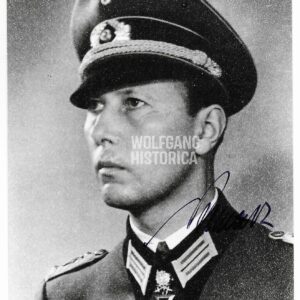
Horst Niemack – Aufklärungs-Abteilung 5 & Panzer-Füsilier-Regiment “Großdeutschland” (Schwertern)
Wilhelm Meendsen-Bohlken – Befehlshaber der Deutschen Marinekommando Italiens (Admiral)
€40,00Original Postwar Signature on a Postwar Photo of Wilhelm Meendsen-Bohlken. Vizeadmiral Wilhelm Meendsen-Bohlken (5 April 1897 † 13 May 1985) was a career naval officer who served in both World Wars and rose to the rank of Vice Admiral in the Kriegsmarine. He was a recipient of the Knight’s Cross of the Iron Cross for his leadership in Italy.
Award:
-
Knight’s Cross of the Iron Cross – 11 May 1944, as Vizeadmiral and Befehlshaber der Deutschen Marinekommando Italien (Commander of German Naval Command Italy).
Career Highlights:
-
Entered the Imperial Navy as a cadet during World War I and gained early seagoing experience.
-
Continued his naval career in the interwar Reichsmarine, specializing in staff and command positions.
-
During World War II, held senior roles including Commander of German Naval Forces in Italy, directing naval operations and coordinating with Axis forces in the Mediterranean theater.
-
Promoted to Vizeadmiral, one of the Kriegsmarine’s senior flag officer ranks.
-
Survived the war and lived until 1985.
Item Details:
-
Authentic postwar signature of Vizeadmiral Wilhelm Meendsen-Bohlken.
-
Signed on a postwar photograph.
-
Condition: Well-preserved with a clear autograph.
Erich Reuter – Infanterie-Regiment 122 & 46. Infanterie-Division (Eichenlaub)
€40,00Original Postwar Signature on a Postwar Photo of Erich Reuter. Generalleutnant Erich Reuter (30 March 1904, Frankfurt an der Oder † 30 October 1989, Bad Nauheim) was a German Army officer who rose to the rank of Generalleutnant during the Second World War. He distinguished himself as a regimental and divisional commander, becoming a recipient of the Knight’s Cross of the Iron Cross with Oak Leaves and the German Cross in Gold.
Awards and Decorations:
-
German Cross in Gold (Deutsches Kreuz in Gold) – 12 March 1942, as Major in Infanterie-Regiment 122.
-
Knight’s Cross of the Iron Cross (Ritterkreuz des Eisernen Kreuzes) – 17 August 1942, as Oberstleutnant and Kommandeur of Infanterie-Regiment 122, 50. Infanterie-Division.
-
Oak Leaves to the Knight’s Cross (Eichenlaub zum Ritterkreuz des Eisernen Kreuzes, 710th award) – 21 January 1945, as Generalmajor and Kommandeur of 46. Infanterie-Division.
Career Highlights:
-
Entered the Reichswehr as a young officer and rose steadily through the interwar years.
-
Commanded Infanterie-Regiment 122 on the Eastern Front, earning both the German Cross in Gold and the Knight’s Cross in 1942.
-
Promoted to divisional command, leading the 46. Infanterie-Division, where his defensive leadership in 1945 brought him the award of the Oak Leaves.
-
Promoted to Generalleutnant before the end of the war.
-
Taken prisoner in 1945, later released, and lived in postwar Germany until his death in 1989.
Item Details:
-
Authentic postwar signature of Generalleutnant Erich Reuter.
-
Signed on a postwar photograph.
-
Condition: Clear, well-preserved autograph.
Walter Hennecke – Seekommandant Normandie (Normandy)
€40,00Original Postwar Signature on a Postwar Photo of Walter Hennecke. Konteradmiral Walter Hennecke (23 May 1898, Betheln † 1 January 1984, Bad Lippspringe) was a German naval officer who rose to the rank of Konteradmiral during the Second World War. He is most remembered for his role as Seekommandant Normandy, where he earned the Knight’s Cross of the Iron Cross in June 1944 for his leadership during the Allied invasion of France.
Awards and Decorations:
-
Knight’s Cross of the Iron Cross (Ritterkreuz des Eisernen Kreuzes) – 26 June 1944, as Konteradmiral and Seekommandant Normandy.
Career Highlights:
-
Entered the Imperial German Navy during the First World War, beginning a career that spanned both world wars.
-
Held various command and staff positions in the Kriegsmarine, specializing in coastal defense and naval artillery.
-
As Seekommandant Normandy, he was responsible for the German coastal defenses during the Allied landings in June 1944.
-
Decorated with the Knight’s Cross in recognition of his command during these decisive battles.
-
Captured by Allied forces and held as a prisoner of war until the conflict’s end.
-
Lived quietly after the war in West Germany until his death in 1984.
Item Details:
-
Authentic postwar signature of Konteradmiral Walter Hennecke.
-
Signed on a postwar photo
-
Condition: Clear, well-preserved autograph.
Collector’s Note:
Hennecke’s signature is scarce, as he was a Knight’s Cross holder and one of the Kriegsmarine officers directly associated with the defense of Normandy during D-Day. The combination of an original postwar photo and letter makes this set particularly desirable for collectors of naval and high-command signatures.
Otto Fretter-Pico – 97. Infanterie-Division
€40,00Original Postwar Signature on a Postwar Photo of Otto Fretter-Pico. General der Artillerie Otto Fretter-Pico (2 February 1893, Karlsruhe † 30 July 1966, Flins, Switzerland) was a career officer who rose to the rank of General der Artillerie in the Wehrmacht during the Second World War. He earned both the German Cross in Gold and the Knight’s Cross of the Iron Cross for his leadership in artillery and divisional command, most notably during the Italian campaign.
Awards and Decorations:
-
German Cross in Gold (Deutsches Kreuz in Gold) – 11 December 1941, as Oberst and Kommandeur of Artillerie-Regiment 297.
-
Knight’s Cross of the Iron Cross (Ritterkreuz des Eisernen Kreuzes) – 12 December 1944, as Generalleutnant and Kommandeur of the 97. Infanterie-Division.
Awarded for his skillful leadership of the 97. Infanterie-Division during a difficult withdrawal across the Maritime Alps, conducted under constant Allied pressure.
Career Highlights:
-
Served in the First World War, remaining in the Reichswehr during the interwar years as an artillery officer.
-
Commanded Artillerie-Regiment 297 in the early campaigns of WWII, where he distinguished himself and earned the German Cross in Gold in 1941.
-
Later appointed commander of the 97. Infanterie-Division, leading it in Italy and southern France.
-
Recognized with the Knight’s Cross for skillfully handling the Division’s withdrawal over the Maritime Alps in late 1944.
-
Promoted to General der Artillerie, one of the senior artillery officers of the Wehrmacht.
-
Captured in 1945 and held as a prisoner of war before release, later retiring to Switzerland, where he died in 1966.
Item Details:
-
Authentic postwar signature of General der Artillerie Otto Fretter-Pico.
-
Signed on a postwar photograph.
-
Condition: Clear and well-preserved autograph.
Collector’s Note:
Fretter-Pico is notable as both a high-ranking artillery commander and a divisional commander in the Italian theater. His award of the Knight’s Cross for the withdrawal over the Maritime Alps highlights his reputation as a tactically skilled officer. Autographs of General der Artillerie rank officers are especially desirable among collectors of Heer high command.
Karl-Ludwig Rhein – Infanterie-Regiment 439 (134. Infanterie-Division)
€40,00Original Postwar Signature on a Postwar Photo of Karl-Ludwig Rhein. Generalleutnant Karl-Ludwig Rhein (30 March 1894, Wetzlar † 27 March 1988) was a German Army officer who rose to the rank of Generalleutnant during the Second World War. He earned both the German Cross in Gold and the Knight’s Cross of the Iron Cross for his leadership of Infanterie-Regiment 439 on the Eastern Front.
Awards and Decorations:
-
German Cross in Gold (Deutsches Kreuz in Gold) – 26 December 1941, as Oberst and commander of Infanterie-Regiment 439, 134. Infanterie-Division.
-
Knight’s Cross of the Iron Cross (Ritterkreuz des Eisernen Kreuzes) – 6 March 1942, as Oberst and commander of Infanterie-Regiment 439, 134. Infanterie-Division.
Career Highlights:
-
World War I veteran who continued his military service in the Reichswehr and later in the Wehrmacht.
-
As commander of Infanterie-Regiment 439, played a crucial role in the heavy fighting on the Eastern Front during the winter of 1941–42.
-
His leadership under extreme conditions earned him both the German Cross in Gold and shortly thereafter the Knight’s Cross of the Iron Cross.
-
Later promoted to Generalleutnant, holding senior leadership positions in the final years of the war.
-
Survived captivity and lived until 1988, passing away at the age of 93.
Item Details:
-
Authentic postwar signature of Generalleutnant Karl-Ludwig Rhein.
-
Signed on a postwar photograph.
-
Condition: Clear and well-preserved autograph.
Collector’s Note:
Rhein’s decorations for his command of Infanterie-Regiment 439 in the 134. Infanterie-Division highlight his frontline leadership during the harsh winter battles of 1941–42. His signature is a desirable piece for collectors of Eastern Front and Heer commanders.
Wilhelm Meendsen-Bohlken – Befehlshaber der Deutschen Marinekommando Italiens (Admiral)
€40,00Original Postwar Signature on a Postwar Photo of Wilhelm Meendsen-Bohlken. Vizeadmiral Wilhelm Meendsen-Bohlken (5 April 1897 † 13 May 1985) was a career naval officer who served in both World Wars and rose to the rank of Vice Admiral in the Kriegsmarine. He was a recipient of the Knight’s Cross of the Iron Cross for his leadership in Italy.
Award:
-
Knight’s Cross of the Iron Cross – 11 May 1944, as Vizeadmiral and Befehlshaber der Deutschen Marinekommando Italien (Commander of German Naval Command Italy).
Career Highlights:
-
Entered the Imperial Navy as a cadet during World War I and gained early seagoing experience.
-
Continued his naval career in the interwar Reichsmarine, specializing in staff and command positions.
-
During World War II, held senior roles including Commander of German Naval Forces in Italy, directing naval operations and coordinating with Axis forces in the Mediterranean theater.
-
Promoted to Vizeadmiral, one of the Kriegsmarine’s senior flag officer ranks.
-
Survived the war and lived until 1985.
Item Details:
-
Authentic postwar signature of Vizeadmiral Wilhelm Meendsen-Bohlken.
-
Signed on a postwar photograph. 10,5x7,5 cm.
-
Condition: Well-preserved with a clear autograph.
Karl-Friedrich Merten – Watch Officer on U-38 & Commander of U-68 (EL)
€45,00Arthur Jüttner – Grenadier-Regiment 532 & 164 (Swords)
€45,00Ernst Kuppinger – 246. Volksgrenadier-Division (Eichenlaub)
€45,00Wilhelm Batz – Jagdgeschwader 52 (Schwertern)
€45,00Original Postwar Signature on a Postwar Photo of Wilhelm "Willi" Batz. Major Wilhelm Batz (21.05.1916 † 11.09.1988) earned the Deutsches Kreuz in Gold on December 13, 1943 with the 5. Staffel/ Jagdgeschwader 52, the Ritterkreuz on March 26, 1944 as Oberleutnant und Staffelkapitän of the 5. Staffel/ Jagdgeschwader 52, the Eichenlaub on July 20, 1944 as Hauptmann und Kommandeur of the II. Gruppe/ Jagdgeschwader 52 and the Schwertern on April 21 ,1945 as Hauptmann und Kommandeur of the II. Gruppe/ Jagdgeschwader 52. Claimed 237 victories!
Read more on Wilhelm Batz (Wikipedia)Provenance: This signature comes from one of the largest postwar signature collection I’ve ever commissioned. This collection was started by a Waffen-SS Veteran, Werner H., in the 1950’s until he passed away.
Hermann Ammer – Grenadier-Regiment 62 (7.Inf.Div.)
€45,00Original Postwar Signature on a Wartime Postcard of Hermann Ammer. Major Hermann Ammer (08.03.1914 in Mamming † 09.12.2000 Vilshofen) earned the Deutsches Kreuz in Gold on May 17, 1943 as Oberleutnant with 3. Kompanie/ Grenadier-Regiment 6 and the Ritterkreuz des Eisernen Kreuzes on October 12, 1943 as Oberleutnant und Führer of II. Bataillon/ Grenadier-Regiment 62 of the 7. Infanterie-Division.
Provenance: This signature comes from one of the largest postwar signature collection I’ve ever commissioned. This collection was started by a Waffen-SS Veteran, Werner H., in the 1950’s until he passed away.
Johannes Wiese – Jagdgeschwader 52 (Eichenlaub)
€45,00Original Postwar Signature on a Postwar Photo of Johannes "Hannes" Wiese. Major Johannes Wiese (07.03.1915 in Breslau † 16.08.1991 in Kirchzarten) earned the Ritterkreuz des Eisernen Kreuzes on January 5, 1943 as Hauptmann und Staffelkapitän of the 2. Staffel/ Jagdgeschwader 52 and the Eichenlaub on March 2, 1944 as Major und Kommandeur of the I. Gruppe/ Jagdgeschwader 52.
Johannes Wiese achieved a total of 133 victories (and 75 unconfirmed) in 480 sorties.Provenance: This signature comes from one of the largest postwar signature collection I’ve ever commissioned. This collection was started by a Waffen-SS Veteran, Werner H., in the 1950’s until he passed away.
Ernst-Wilhelm Hoffmann – Panzergrenadier-Regiment 12 (4. Panzer-Division) (Eichenlaub)
€45,00Original Postwar Signature on a Postwar Photo of Ernst-Wilhelm Hoffmann. Oberst Ernst-Wilhelm (29.09.1904 in Nürnberg † 27.08.1994 in Gräfelfin) earned the Ritterkreuz des Eisernen Kreuzes on September 4, 1940 as Major und Kommandeur of the I. Bataillon/ Schützen-Regiment 12 and the Eichenlaub on June 9, 1944 as Oberstleutnant und Kommandeur of the Panzergrenadier-Regiment 12 of the 4. Panzer-Division.
Provenance: This signature comes from one of the largest postwar signature collection I’ve ever commissioned. This collection was started by a Waffen-SS Veteran, Werner H., in the 1950’s until he passed away.Wolfgang Koltermann – schwere Panzer-Abteilung 507 (Tiger)
€45,00Original Scarce Postwar Signature on a Postwar Photo of Wolfgang Koltermann. Oberleutnant Wolfgang Koltermann (28.03.1917 in Schönlake † 21.12.1994 in Augsburg) earned the Ritterkreuz des Eisernen Kreuzes on March 11, 1945 as Oberleutnant and Chef of the 3. Kompanie/ schwere Panzer-Abteilung 507 (Tiger).
Provenance: This signature comes from one of the largest postwar signature collection I’ve ever commissioned. This collection was started by a Waffen-SS Veteran, Werner H., in the 1950’s until he passed away.
Johann Sinnhuber – 28. Infanterie-Division
€45,00Original Postwar Signature on a Card of Johann Sinnhuber. General der Artillerie Johann Sinnhuber (27.03.1887 † 23.10.1974) earned the Ritterkreuz on July 5, 1941 as Generalleutnant und Kommandeur of the 28. Infanterie-Division.
Provenance: This signature comes from one of the largest postwar signature collection I’ve ever commissioned. This collection was started by a Waffen-SS Veteran, Werner H., in the 1950’s until he passed away.
Heinrich Eberbach – Panzer-Regiment 35 & Panzer-Brigade 5 (Eichenlaub)
€45,00Original Postwar Signature on a Postwar Photo of Heinrich Eberbach. General der Panzertruppen Heinrich Eberbach (24.11.1895 in Laufen am Neckar † 13.07.1992 in Notzingen) earned the Ritterkreuz des Eisernen Kreuzes on July 4, 1940 as Oberstleutnant und Kommandeur of the Panzer-Regiment 35 and the Eichenlaub on December 31, 1941 as Oberst und Kommandeur of the 5. Panzer-Brigade.
Provenance: This signature comes from one of the largest postwar signature collection I’ve ever commissioned. This collection was started by a Waffen-SS Veteran, Werner H., in the 1950’s until he passed away.
Otto Carius – schwere Panzer-Abteilung 502 (Eichenlaub, Tiger!)
€45,00Otto Carius – schwere Panzer-Abteilung 502 (Eichenlaub, Tiger!)
€45,00Gerhard Triepel genannt Schulze – Artillerie-Kommandeur 485 (LXXXV. Armeekorps)
€45,00Original Postwar Signature on a Postwar Photo of Gerhard Triepel genannt Schulze. Generalmajor Gerhard Triepel genannt Schulze (12 May 1899 † 28 May 1980) was a German Army officer during the Second World War who rose to the rank of Generalmajor. He distinguished himself as an artillery commander on the Western Front in 1944, earning the German Cross in Gold.
Award:
-
German Cross in Gold (Deutsches Kreuz in Gold) – 16 October 1944, as Oberst and Kommandeur of Artillerie-Kommandeur 485, LXXXV. Armeekorps (Heer).
Career Highlights:
-
Entered military service after the First World War and remained a career officer in the interwar Reichswehr.
-
During World War II, commanded artillery formations and later senior staff positions.
-
Earned the German Cross in Gold for his leadership of Artillerie-Kommandeur 485 under the LXXXV. Armeekorps, during the bitter defensive battles of late 1944.
-
Promoted to Generalmajor, holding divisional-level responsibilities before the war’s end.
-
Survived captivity and lived in postwar Germany until his death in 1980.
Enno von Rintelen – German Military Attaché in Italy (DKIS)
€45,00Original Postwar Signature on a Postwar Photo of Enno Emil von Rintelen. General der Infanterie Enno von Rintelen (6 November 1891, Stettin † 7 August 1971, Heidelberg) was a German officer whose military career spanned both World Wars. Rising to the rank of General der Infanterie, he is best remembered as the German Military Attaché in Italy and later as the Wehrmacht’s official representative at the Italian Supreme Command, where he played a central role in coordinating military relations between Germany and Italy.
Awards and Decorations:
-
German Cross in Silver (Deutsches Kreuz in Silber) – for his distinguished diplomatic and organizational service as German Military Attaché in Rome and representative to the Italian High Command.
-
Both classes of the Iron Cross (1914), awarded during his service in the First World War.
Career Highlights:
-
Entered the Prussian Army in 1910 and served throughout the First World War.
-
Remained in the Reichswehr during the interwar period, holding a variety of staff and command roles.
-
From 1936 to 1943, served as Military Attaché in Rome, later as German General at Comando Supremo, where he acted as liaison between the Wehrmacht and the Italian armed forces.
-
Promoted through the general officer ranks, ultimately reaching General der Infanterie in 1942.
-
Retired from active service in late 1944.
-
After the war, authored memoirs detailing his time as attaché in Italy, offering a rare perspective on the German-Italian alliance.
-
Lived in postwar Germany until his death in 1971.
Item Details:
-
Authentic postwar signature of General der Infanterie Enno von Rintelen.
-
Signed on a postwar photograph.
-
Condition: Clear, well-preserved autograph.
Martin Harlinghausen – X. Fliegerkorps & Fliegerführer Atlantik (Eichenlaub)
€45,00Original Postwar Signature on a Postwar Photo of Martin Harlinghausen. Generalmajor Martin Harlinghausen (17 January 1902, Rheda † 22 May 1986, Düsseldorf) was a Luftwaffe officer who rose to the rank of Generalmajor and became one of the key figures in German maritime and anti-shipping air operations during the Second World War. He was decorated with the Knight’s Cross of the Iron Cross with Oak Leaves for his service as Chief of Staff of X. Fliegerkorps, which directed Luftwaffe operations against Allied naval forces.
Awards and Decorations:
-
Knight’s Cross of the Iron Cross (Ritterkreuz des Eisernen Kreuzes) – 4 May 1940, as Major im Generalstab and Chef des Stabes of X. Fliegerkorps, Luftwaffe.
-
Wehrmachtbericht Mention – 3 November 1940, cited in the official Wehrmacht communique.
-
Oak Leaves to the Knight’s Cross (Eichenlaub zum Ritterkreuz des Eisernen Kreuzes, 8th award) – 30 January 1941, as Oberstleutnant im Generalstab and Chef des Stabes of X. Fliegerkorps, Luftwaffe.
Career Highlights:
-
Entered the Luftwaffe in the 1930s, specializing in planning and operational staff roles.
-
As Chief of Staff of X. Fliegerkorps, was heavily involved in the planning and execution of Luftwaffe operations against Allied naval targets in the North Sea, Norway, and the Atlantic approaches.
-
Worked closely with Luftwaffe long-range bomber units and naval command to coordinate strikes against convoys and shipping.
-
Promoted to Generalmajor, later serving in higher staff and command positions in Luftwaffe maritime operations.
-
Captured at the end of the war and released from captivity in the late 1940s.
-
Lived in West Germany until his death in 1986.
Item Details:
-
Authentic postwar signature of Generalmajor Martin Harlinghausen.
-
Signed on a postwar photograph.
-
Condition: Clear, well-preserved autograph.
Wolf Hagemann – Gebirgsjäger-Regiment 139 & 336. Infanterie-Division (Narvik, Eichenlaub)
€45,00Original Postwar Signature on a Postwar Photo of Wolf Hagemann. Generalleutnant Wolf Hagemann (23 March 1898, Metz † 15 October 1983, Göttingen) was a German Army officer who rose to the rank of Generalleutnant during the Second World War. He was twice decorated for distinguished leadership in battle, earning the Knight’s Cross of the Iron Cross with Oak Leaves.
Awards and Decorations:
-
Knight’s Cross of the Iron Cross (Ritterkreuz des Eisernen Kreuzes, Nr. 211) – 4 September 1940, as Oberstleutnant and Kommandeur of III./Gebirgsjäger-Regiment 139, 3. Gebirgs-Division.
Awarded for his leadership and bravery in the Battle of Narvik (Norway, 1940), where his battalion played a decisive role in the successful mountain warfare operations against Allied forces.
-
Oak Leaves to the Knight’s Cross (Ritterkreuz mit Eichenlaub, 484th award) – 4 June 1944, as Generalmajor and Kommandeur of 336. Infanterie-Division, 17. Armee, Heeresgruppe Südukraine.
Recognized for his division’s stubborn defensive performance on the Crimean front. On 8 April 1944, his troops repulsed a major Soviet attack against the Siwasch straits. Later, during 5–12 May 1944, he successfully delayed a Soviet breakthrough until the evening of 6 May, a feat of vital importance for the survival of the 17. Armee. The Oak Leaves were personally presented to him by Adolf Hitler on 22 June 1944.
Career Highlights:
-
Served as a young officer in World War I, remaining in the Reichswehr after the war.
-
Distinguished himself early in World War II with the 3. Gebirgs-Division in Norway, where his leadership at Narvik earned him the Knight’s Cross.
-
Later promoted to divisional command, leading the 336. Infanterie-Division in the desperate defensive battles in the Crimea, earning the Oak Leaves for his leadership.
-
Promoted to Generalleutnant, continuing to command until the final phases of the war.
-
Captured in 1945 and held in captivity before returning to civilian life in West Germany. He lived until 1983.
Item Details:
-
Authentic postwar signature of Generalleutnant Wolf Hagemann.
-
Signed on a postwar photograph. Size: 7,3x10,5cm.
-
Condition: Clear and well-preserved autograph.
Collector’s Note:
Wolf Hagemann’s dual decorations — the Knight’s Cross for Narvik and the Oak Leaves for his stand in the Crimea — mark him as one of the more notable divisional commanders of the Heer. His autograph is especially desirable for collectors focusing on the Gebirgsjäger and the Eastern Front’s late-war battles.
Franz Griesbach – Grenadier-Regiment 399 (Schwertern)
€45,00Original Postwar Signature on a Postwar Photo of Franz Griesbach. Generalmajor Franz Griesbach (21 December 1892 † 24 September 1984) was a German officer of the Heer who rose to the rank of Generalmajor during the Second World War. A highly decorated front-line commander, he was awarded the Knight’s Cross of the Iron Cross with Oak Leaves and Swords for his leadership of infantry regiments in the bitter fighting on the Eastern Front.
Awards and Decorations:
-
Knight’s Cross of the Iron Cross (Ritterkreuz des Eisernen Kreuzes) – 14 March 1942, as Major and Kommandeur of I./Infanterie-Regiment 391, 170. Infanterie-Division.
-
Oak Leaves to the Knight’s Cross (Ritterkreuz mit Eichenlaub, 252nd award) – 17 May 1943, as Oberst and Kommandeur of Grenadier-Regiment 399, 170. Infanterie-Division.
-
Swords to the Knight’s Cross (Ritterkreuz mit Eichenlaub und Schwertern, 65th award) – 6 March 1944, as Oberst and Kommandeur of Grenadier-Regiment 399, 170. Infanterie-Division.
Career Highlights:
-
World War I veteran who continued his career in the interwar Reichswehr and later the Wehrmacht.
-
Distinguished himself early on the Eastern Front, earning the Knight’s Cross in 1942 for his leadership of I./Infanterie-Regiment 391.
-
As commander of Grenadier-Regiment 399, he led his men through some of the hardest battles of 1943–44, earning both the Oak Leaves and later the Swords to the Knight’s Cross.
-
Promoted to Generalmajor, one of the few officers of his rank to be awarded the Knight’s Cross with Oak Leaves and Swords.
-
Survived the war, captivity, and lived until 1984.
Item Details:
-
Authentic postwar signature of Generalmajor Franz Griesbach.
-
Signed on a postwar photograph.
-
Condition: Clear and well-preserved autograph.
Collector’s Note:
Griesbach’s decorations mark him as one of the rare recipients of the Knight’s Cross with Oak Leaves and Swords, awarded only 159 times during the war. His leadership of regiments in the 170. Infanterie-Division on the Eastern Front makes this signature especially desirable for collectors of high-ranking and highly decorated Heer officers.
Friedrich von Volckamer und Kirchensittenbach – 8. Jäger-Division
€45,00Original Postwar Signature on a Postwar Photo of Friedrich von Volckamer und Kirchensittenbach. Generalleutnant Friedrich von Volckamer und Kirchensittenbach (16 April 1894 † 3 April 1989) was a German Army officer who rose to the rank of Generalleutnant during the Second World War. He was decorated with both the German Cross in Gold and the Knight’s Cross of the Iron Cross for his leadership of the 8. Jäger-Division on the Eastern Front.
Awards and Decorations:
-
German Cross in Gold (Deutsches Kreuz in Gold) – 3 November 1943, as Generalmajor with 8. Jäger-Division.
-
Knight’s Cross of the Iron Cross (Ritterkreuz des Eisernen Kreuzes) – 26 March 1944, as Generalleutnant and Kommandeur of 8. Jäger-Division.
Career Highlights:
-
World War I veteran who continued his career into the Reichswehr and later the Wehrmacht.
-
Took command of the 8. Jäger-Division, a formation specialized in combat in difficult terrain and often used in challenging defensive operations on the Eastern Front.
-
Awarded the German Cross in Gold in late 1943 for his division’s performance in heavy combat.
-
Decorated with the Knight’s Cross in March 1944 for his leadership during intense defensive battles against the Red Army.
-
Survived the war and lived until 1989, reaching the age of 94.
Item Details:
-
Authentic postwar signature of Generalleutnant Friedrich von Volckamer und Kirchensittenbach.
-
Signed on a postwar photograph.
-
Condition: Excellent, with a clear and well-preserved autograph.
Collector’s Note:
As a decorated divisional commander and recipient of both the German Cross in Gold and the Knight’s Cross, von Volckamer und Kirchensittenbach’s signature is a desirable addition to any collection of Eastern Front and Heer memorabilia. His leadership of the 8. Jäger-Division represents the specialized and often overlooked role of the Jäger formations within the Wehrmacht.
Hubertus-Maria Ritter von Heigl – Pionier-Bataillon 70
€45,00Original Postwar Signature on a Postwar Photo of Hubertus-Maria Ritter von Heigl. Generalmajor Hubertus-Maria Ritter von Heigl (10 November 1897, Siegenburg † 24 January 1985, München) was a German officer of the Heer who rose to the rank of Generalmajor during the Second World War. A career pioneer officer, he was decorated with the Knight’s Cross of the Iron Cross for his leadership of Pionier-Bataillon 70 during the early stages of the war in the East.
Awards and Decorations:
-
Knight’s Cross of the Iron Cross (Ritterkreuz des Eisernen Kreuzes) – 13 January 1942, as Oberstleutnant and Kommandeur of Pionier-Bataillon 70.
Career Highlights:
-
World War I veteran who continued his career through the Reichswehr and into the Wehrmacht.
-
Specialized in combat engineering and pioneer operations, serving as commander of Pionier-Bataillon 70.
-
Awarded the Knight’s Cross in early 1942 for his successful leadership of assault and engineering operations on the Eastern Front.
-
Later promoted to Generalmajor, continuing to serve in command and staff functions until the end of the war.
-
Survived captivity and lived in Munich until his death in 1985.
Item Details:
-
Authentic postwar signature of Generalmajor Hubertus-Maria Ritter von Heigl.
-
Signed on a postwar photograph.
-
Condition: Clear, bold autograph.
Collector’s Note:
Ritter von Heigl is among the distinguished pioneer commanders recognized with the Knight’s Cross. His signature is a fine addition for collectors focusing on decorated officers of the Wehrmacht’s specialized branches, particularly combat engineers (Pioniere).
Erwin Jollasse – Schützen-Regiment 52 (18. Panzer-Division)
€45,00Original Postwar Signature on a Postwar Photo of Erwin Jollasse. Generalleutnant Erwin Jollasse (8 December 1892, Hamburg † 14 March 1987, Tutzing) was a German officer who rose to the rank of Generalleutnant during the Second World War. A veteran infantry and Panzergrenadier commander, he was decorated with both the Knight’s Cross of the Iron Cross and the German Cross in Gold for his leadership on the Eastern Front.
Awards and Decorations:
-
Knight’s Cross of the Iron Cross (Ritterkreuz des Eisernen Kreuzes) – 2 November 1941, as Oberst and Kommandeur of Schützen-Regiment 52, 18. Panzer-Division.
-
German Cross in Gold (Deutsches Kreuz in Gold) – 6 January 1944.
Career Highlights:
-
World War I veteran who continued his service in the Reichswehr and later the Wehrmacht.
-
Commanded Schützen-Regiment 52 of the 18. Panzer-Division during the opening campaigns in the Soviet Union, where his leadership earned him the Knight’s Cross in late 1941.
-
Later recognized with the German Cross in Gold in 1944 for continued distinguished command achievements.
-
Rose to the rank of Generalleutnant, serving in staff and divisional command roles during the later stages of the war.
-
Survived the war and lived until 1987, passing away in Tutzing at the age of 94.
Item Details:
-
Authentic postwar signature of Generalleutnant Erwin Jollasse.
-
Signed on a postwar photograph.
-
Condition: Excellent, with a clear and well-preserved autograph.
Collector’s Note:
Jollasse’s long service career and his distinction as both a Knight’s Cross and German Cross in Gold recipient make his autograph an attractive addition for collectors of decorated Heer officers, particularly those connected with the 18. Panzer-Division and Eastern Front operations.
Armin Lembke – Grenadier-Regiment 220
€50,00Josef Kammhuber – 1. Nachtjagd-Division & Kammhuber Line
€50,00Original Postwar Signature on a Postwar Photo of Josef Kammhuber. General der Flieger Josef Kammhuber (19 August 1896, Minden † 25 January 1986, Bonn) was a German Luftwaffe officer who rose to the rank of General der Flieger and became the founding commander of Germany’s night fighter arm. He was decorated with the Knight’s Cross of the Iron Cross and was cited several times in the Wehrmachtbericht for the success of his units. After the war, he joined the Bundeswehr, where he became the first Inspector of the Air Force (Inspekteur der Luftwaffe), shaping West Germany’s postwar air defense.
Awards and Decorations:
-
Wehrmachtbericht Mention – 10 April 1941: Night fighter units under Kammhuber, along with flak and naval artillery, shot down 16 aircraft in one night and 7 the night before.
-
Knight’s Cross of the Iron Cross (Ritterkreuz des Eisernen Kreuzes) – 9 July 1941, as Generalmajor and Kommandeur of 1. Nachtjagd-Division.
-
Wehrmachtbericht Mention – 27 March 1942: Night fighter units under Kammhuber’s leadership celebrated their 500th aerial victory.
-
Wehrmachtbericht Mention – 31 May 1942: His night fighter units achieved their 600th aerial victory. On this night, Hauptmann Streib claimed his 25th and 26th night victories, while Oberleutnant Knacke achieved his 20th.
Career Highlights:
-
Veteran of the First World War, later returning as a professional officer in the Luftwaffe.
-
Appointed commander of the newly created 1. Nachtjagd-Division, becoming the first general of night fighters.
-
Creator of the “Kammhuber Line”, a radar-guided system of defensive night fighter sectors, pioneering integrated air defense concepts.
-
Though eventually compromised by Allied countermeasures, his system laid the groundwork for modern air defense doctrine.
-
Clashed with Erhard Milch and was removed from night fighter command in 1943, later serving as Luftwaffe commander in Scandinavia.
-
After the war, joined the Bundeswehr in 1956, reaching the rank of General der Flieger and serving as the Luftwaffe’s first Inspector.
-
Retired in 1962 and lived in Bonn until his death in 1986.
Item Details:
-
Authentic postwar signature of General der Flieger Josef Kammhuber.
-
Signed on a postwar photograph.
-
Condition: Clear, well-preserved autograph.
Collector’s Note:
As the architect of the Luftwaffe night fighter arm, a Knight’s Cross recipient, and a multiple Wehrmachtbericht honoree, Kammhuber’s signature is highly sought after. His postwar career as the Bundeswehr’s first Inspector of the Air Force gives his autograph a rare dual importance — bridging the Luftwaffe of the Second World War with NATO’s Cold War air defense.
Job Odebrecht – 6. Flak-Division & II. Flak-Korps
€50,00Original Postwar Signature on a Postwar Photo of Job Odebrecht. General der Flakartillerie Job Odebrecht (20 February 1892, Ehrenbreitstein † 20 November 1982, Bad Homburg vor der Höhe) was a senior Luftwaffe officer who rose to the rank of General der Flakartillerie. He commanded flak formations in both Germany and on active fronts, earning the German Cross in Gold and the Knight’s Cross of the Iron Cross for his leadership of heavy anti-aircraft units.
Awards and Decorations:
-
German Cross in Gold (Deutsches Kreuz in Gold) – 20 October 1942, as Generalmajor and commander of the 6. Flak-Division.
-
Knight’s Cross of the Iron Cross (Ritterkreuz des Eisernen Kreuzes) – 5 September 1944, as General der Flakartillerie and Kommandierender General of II. Flak-Korps.
Career Highlights:
-
A career artillery officer who transferred into the Luftwaffe, specializing in Flak (anti-aircraft) units.
-
By 1942, commanded the 6. Flak-Division, earning the German Cross in Gold for his unit’s defensive performance against Allied air raids.
-
Promoted to General der Flakartillerie and appointed Kommandierender General of II. Flak-Korps, where he directed large-scale flak operations in 1944.
-
Captured at the war’s end and later released from captivity.
-
Lived in West Germany until his death in 1982.
Item Details:
-
Authentic postwar signature of General der Flakartillerie Job Odebrecht.
-
Signed on a large-format postwar photograph (17 × 12.4 cm).
- Condition: Clear, bold autograph.
Collector’s Note:
Odebrecht’s signature is highly valued among Luftwaffe collectors, particularly for his senior role in the Flak arm, which played a critical defensive role in the Reich during the Allied bombing campaign.
Arno Breker – Third Reich’s State Sculptor
€50,00Original Postwar Signature on a Postwar Photo of Arno Breker. Arno Breker (19 July 1900, Elberfeld † 13 February 1991, Düsseldorf) was a renowned German sculptor, widely regarded as one of the most important artists of the 20th century. He achieved international recognition during the 1930s and 1940s as the official state sculptor of the Third Reich, where his monumental works symbolized classical ideals of strength, heroism, and beauty.
Career Highlights:
-
Studied at the Düsseldorf Academy of Arts and later in Paris, where he became acquainted with leading figures of the art world such as Pablo Picasso and Aristide Maillol.
-
Returned to Germany in the mid-1930s, quickly rising to prominence as the favored sculptor of the regime. His colossal statues adorned major buildings and exhibitions, including those designed by Albert Speer.
-
Served as a professor at the Berlin Academy of Arts and was granted the title of “State Sculptor.”
-
After 1945, he continued to work as an artist, focusing on portraiture and smaller-scale sculptures. Despite controversy surrounding his wartime prominence, he maintained a respected career in postwar Germany and abroad.
-
Notable works include “Die Partei” and “Die Wehrmacht” created for the Reich Chancellery, as well as numerous heroic nudes and portraits.
Postwar Recognition:
-
In later decades, Breker worked with and portrayed many famous personalities, including Jean Cocteau, Salvador Dalí, and Anwar Sadat.
-
His artistic legacy remains significant, though deeply intertwined with the politics of his time.
Item Details:
-
Authentic postwar signature of Arno Breker.
-
Signed on a postwar photograph.
-
Condition: Excellent, bold signature with clear presentation.
Collector’s Note:
Breker’s autograph is of special interest not only to collectors of wartime history but also to those in the field of fine arts. As one of the most prominent sculptors of his era, his works—and his signature—bridge the world of politics, art, and history.


